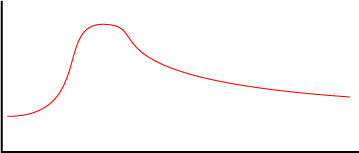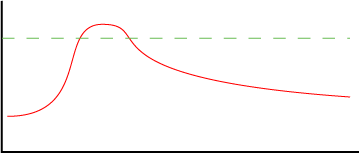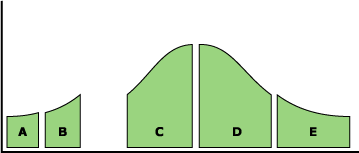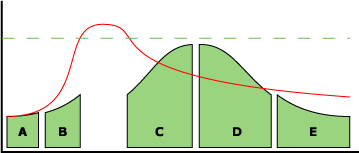I've been thinking about the adoption of new ideas lately, both in companies and in the market at large. Inspired by the Cambrian Explosion and subsequent die-off, I've been thinking about what happens to people's perceptions when new ideas come along.
Thought 1: Idea definitions narrow with time
When a substantial new idea appears, the boundaries of the definition of that idea are not known. There are many different interpretations of the idea. However, as time goes on, the number of new definitions slows, the idea space is explored, fewer variations appear and, finally, the number of things that define a concept are reduced. This looks like this:
Thought 2: A comprehension threshold
There is a point at which the number of variations on an idea becomes too great to communicate a coherent version of that idea to an uninitiated audience. In other words, if there are too many alternative interpretations of an idea to choose from, if someone hasn�t been primed by experience with similar ideas, or by in-depth research to understand the commonality between all of the variations on an idea, they won't get it. Or if they get it, they'll either get a rudimentary version of it or a distorted, incorrect, one.
NOTE: I'm intentionally simplifying this. In reality, I think that exposure to ideas makes them more comprehensible, so the right edge of the threshold is likely higher than the left, but for the sake of this discussion, I've made it a simple horizontal line.
Thought 3: Comprehension thresholds create Moore's chasm
Geoffrey Moore defined a chasm in new technology adoption in his book "Crossing the Chasm." In it, he divides the adoption market for a given technology into 5 divisions:
A: Technology enthusiasts
B: Visionaries
C: Pragmatists
D: Conservatives
E: Skeptics
Note: I've cut off the two most trailing ends of the bell curve�theoretically it goes all the way to 0 on both ends.
The graph represents market size for sections of a market, but it can also be read left to right as the sequence in which a technology is adopted, which is how Moore's chasm appears (roughly speaking, of course�in reality, the gaps represents the difficulty of reaching a market, not time, but it's a reasonable abstract model). His insight is that, for some reason, it's hard to get Pragmatists to adopt a new idea and it may take a lot of energy, time or money to cross it. Moore's theory is that Pragmatists want something that "just works," unlike Technology Enthusiasts, who like the tech for the sake of the tech, or Visionaries, who are enamored with what the tech could be.
But what does "just works" mean? Moore talks about the qualities Pragmatists are looking for in a product�that it be stable, reliable, supported, etc�but I have a different theory. I think that they buy the product when they can be bothered to understand the idea it represents (and thus, the idea's value), and they only understand the idea when the number of competing variations is small enough to not be confusing. In other words, until the number of competing variations on an idea drops below the comprehension threshold, Pragmatists won't care to understand it.
This means that the chasm is that period between the time when an idea crosses the confusion threshold and the time that the number of variations drops to the point that people care to grok what it means (and it's not that they can't understand it, it's just that there are too many options for them to filter through).





You should look into Purple Cow by Seth Godin. He comes to the same conclusion as you and provides insights on how to take advantage of the situation.
Cool!
There's also "The Sociology of Philosophies: A Global Theory of Intellectual Change" by Randall Collins, which I just discovered yesterday. It's 1000 pages long, so I suspect I won't be reading it right off, but it's on the Amazon wish list now. ;-)
http://www.hup.harvard.edu/contents/COLSOC_toc.html
damn html.
http://newideasaboutnewideas.com/
I will loan you my copy of New Ideas About New Ideas, which I think you will like...
I've been thinking about TiVo (or however you are supposed to do the caplitalization there) because of some paralells with a client's product - there's something there about an idea that is only understandable at first as a combination of other ideas, depending on your orientation/experience.
TiVo is a DVR or a PVR (whatever jargon you like), which if you read blogs you probably know what that means. Some digital technology that handles digital-like functions around video recording.
But to explain TiVo to a variety of people who haven't used it or seen it requires a bunch of different "features" - none of which really get to the point
- pause live TV
- subscribe to a fave TV show, every week
- tapeless VCR
- goes and finds programs that you didn't ask it to, that you might like
Those are very different, at least if you don't understand what the hell a DVR is. So, articulating the experience of the product in a way that is saleable/marketable seems like a challenge. I've never worked in this category directly, but in talking to users about home entertainment and other home technologies, I've seen that their own interpretation of it varies, and most don't articulate the DVR idea as much as some subset of the list above. Other times I've tried to tell people about the product and what it does, and have only been able to connect around enumerating that list...
Anyway :)